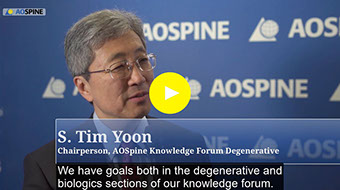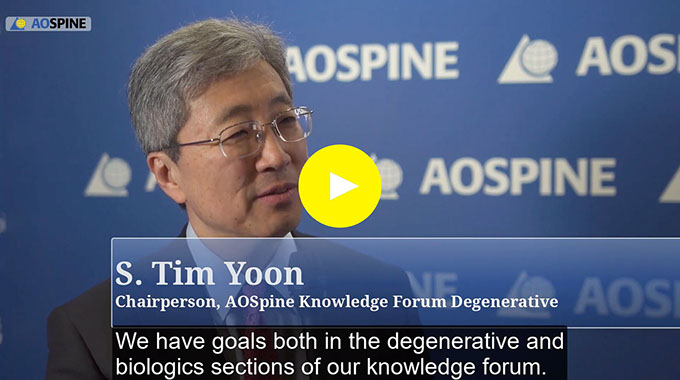
The AO Spine BOnE Classification—a path to evidence on bone grafts to improve outcomes
Menu
The AO Spine KF Degenerative Steering Committee members Jeff Wang (left) and Hans-Joerg Meisel with Chairperson S Tim Yoon (far right) and Zorica Buser, Toronto, Canada, May 2019.
The AO Spine BOnE Classification—a path to evidence on bone grafts to improve outcomes
The AO Spine Knowledge Forum (KF) Degenerative is developing a much needed Osteobiologics Classification, the “BOnE Classification” for short. Many surgeons are using osteobiologics that may have questionable efficacy, sometimes at significant cost. With this classification, the KF will make it easier for all stakeholders—surgeons, patients, hospitals, insurance providers, and governments—to assess the level of evidence of a particular osteobiologic material to support its use.
Chairperson and Principal Investigator (PI) S Tim Yoon explains there is currently a lack of governmental regulation regarding many classes of osteobiologics. “We have a situation where sometimes we have very scarce scientific evidence to show the efficacy of the osteobiologics in clinical use.”
The AO Spine BOnE Classification is a tool designed for evidence evaluation. Yoon explains it will“The BOnE Classification is an evidence evaluation tool that can lead to better choices.” provide a way to classify evidence by classifying osteobiologic-related studies. “This in turn will provide an evidence level or even evaluation of an osteobiologic. Hopefully it will lead to better choices by purchasers and encourage vendors to develop sound scientific evidence to show the efficacy of their products.”
Co-PI Zorica Buser agrees there is a desperate need for a tool to rate biologics. “Currently the spine field is flooded with osteobiologics that cost a lot, however, the evidence is missing to justify the widespread use. The BOnE Classification will close this gap and help our spine community understand what biologics have been vetted with evidence, ultimately leading to better treatment planning and patient outcomes.”


 The AO Spine KF Degenerative in Toronto, Canada, May 2019.Buser believes the AO Spine BOnE Classification will be a great medium for collaborative interactions between surgeons, researchers, and industry on improving osteobiologics while minimizing the costs.AO Spine KF Degenerative is developing a framework to evaluate the level of evidence supporting the use of bone grafts. Meeting in Toronto, Canada, May 2019.3 - 3
The AO Spine KF Degenerative in Toronto, Canada, May 2019.Buser believes the AO Spine BOnE Classification will be a great medium for collaborative interactions between surgeons, researchers, and industry on improving osteobiologics while minimizing the costs.AO Spine KF Degenerative is developing a framework to evaluate the level of evidence supporting the use of bone grafts. Meeting in Toronto, Canada, May 2019.3 - 3
Treatment planning simplified
There are three main levels of evidence in the Classification: human, animal, and in vitro data. Each of the major levels is further subclassified into four categories. The highest level of evidence is a well performed clinical randomized controlled trial and the lowest level of evidence is non-quantitative in vitro data. (1)
Already in the early stages, the KF tested the BOnE Classification on a few biologics. “Not surprisingly, some of the biologics that are commonly used received a low grade with our classification. This confirms that osteobiologics use is not evidence driven, but often sales force driven,” Buser says. The KF Steering Committee member Jeff Wang also keeps highlighting the issue.
“The AO Spine BOnE classification will be a great medium for collaborative interactions.”
“We hope to build a consensus acceptance on this classification system. Eventually, we could have every osteobiologics paper classified as it is published in the scientific journals,” Yoon explains. The aim is to create a living tool with the latest information. This will bring the spine community certainty of the grade given to a particular biologics. Based on the grade, surgeons, researchers, and industry can make decisions on next steps.
Buser encourages all surgeons to familiarize themselves with the AO Spine BOnE Classification. “The BOnE Classification will simplify surgeons’ decision making when it comes to choosing which osteobiologic to use. It will help navigate through the overwhelming number of biologics and their various generations.”
To learn more, join the AO Spine KF Degenerative symposium on “Current clinical evidence for osteobiologics in spine surgery: redefining what we know” at the Global Spine Congress in Rio de Janeiro, Brazil, in May.
(1) Wang JC, Yoon ST, Brodke DS, Park J-B, Hsieh P, Meisel H-J, Buser Z Development of AOSpine BOnE (Bone Osteobiologics and Evidence) Classification. [E-pub] Global Spine Journal, 2019. https://journals.sagepub.com/doi/full/10.1177/2192568219880176









